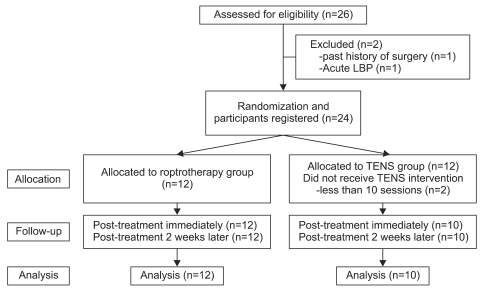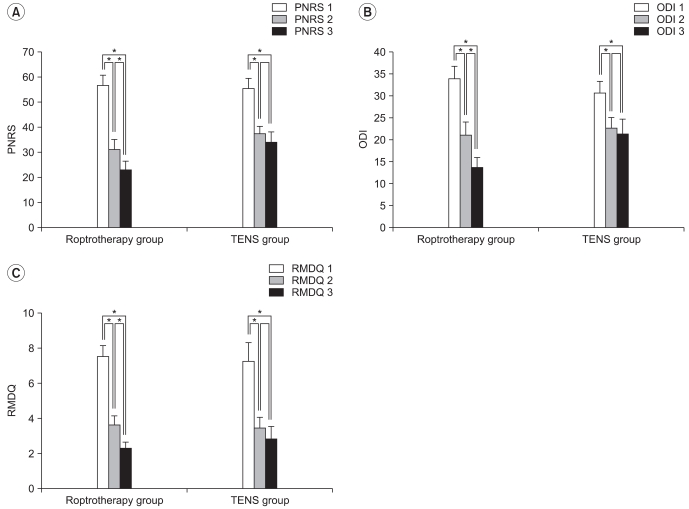Ann Rehabil Med.
2012 Feb;36(1):55-65. 10.5535/arm.2012.36.1.55.
Development and Application of a Newly Designed Massage Instrument for Deep Cross-Friction Massage in Chronic Non-Specific Low Back Pain
- Affiliations
-
- 1Department of Rehabilitation Medicine, Jesus Hospital, Jeonju 560-750, Korea. withjoy9@naver.com
- KMID: 2266781
- DOI: http://doi.org/10.5535/arm.2012.36.1.55
Abstract
OBJECTIVE
To introduce a newly designed massage instrument, the Hand Grip T-bar (HT-bar) and use it to relieve chronic non-specific low back pain (nLBP) through deep cross-friction massage (roptrotherapy). METHOD: 22 subjects (9 males and 13 females, aged 51.6+/-6.7) with chronic nLBP were allocated randomly to a Roptrotherapy group (n=12) and a Transcutaneous Electrical Nerve Stimulation (TENS) group (n=10). The Roptrotherapy group received deep cross-friction massage with the HT-bar, which was made of metal and had a cylinder for increasing weight and grooves for an easy grip. It was applied across the middle and lower back for 20 minutes a day, 3 days a week for 2 weeks. The TENS group received TENS for 20 minutes a day, 5 days a week for 2 weeks. The outcome was measured on the pain numeric rating scale (PNRS), by the Oswestry disability index (ODI), and by the Roland & Morris Disability Questionnaire (RMDQ) at pre-treatment, at immediate post-treatment and 2 weeks later. The application of the HT-bar was assessed by a questionnaire to 19 therapists.
RESULTS
At post-treatment, immediately and 2 weeks later, both groups showed significant improvement in PNRS, ODI and RMDQ. During the two weeks after post-treatment, however, the Roptrotherapy group improved in PNRS, ODI and RMDQ, but the TENS group did not. Over 80% of the therapists responded that the HT-bar was useful and comfortable.
CONCLUSION
This study suggests that deep cross-friction massage can be a beneficial therapeutic technique and that the HT-bar can be a useful instrument in deep cross-friction massage for chronic nLBP patients.
Keyword
MeSH Terms
Figure
Reference
-
1. Andersson HI. The epidemiology of chronic pain in a Swedish rural area. Qual Life Res. 1994; 3(Suppl 1):S19–S26. PMID: 7866366.
Article2. Gailey RS, Raya MA. Gonzalez EG, Myers SJ, Edelstein JE, Lieberman JS, Downey JA, editors. Manual modalities. Downey and Darling's physiological basis of rehabilitation medicine. 2001. 3rd ed. Boston: Butterworth-Heinemann;p. 761–776.3. Farasyn A, Meeusen R, Nijs J. A pilot randomized placebo-controlled trial of Roptrotherapy in patients with subacute non-specific low back pain. J Back Musculoskelet Rehabil. 2006; 19:111–117.
Article4. Hong SG. A study on the related factors of musculoskeletal disease among physical therapists in Korea. 2004. Asan: Soonchunhyang university graduate.5. Lord BA, Parsell B. Measurement of pain in the prehospital setting using a visual analogue scale. Prehospital and Disaster Medicine. 2003; 18:353–358. PMID: 15310048.
Article6. Kim J, Yoon SH, Rah UW, Cho KH, Hong J. Effect of repetitive magnetic stimulation and transcutaneous electrical nerve stimulation in chronic low back pain: a pilot study. J Korean Acad Rehabil Med. 2010; 34:725–729.7. Bonetti F, Curti S, Mattioli S, Mugnai R, Vanti C, Violante FS, Pillastrini P. Effectiveness of a 'Global Postural Reeducation' program for persistent low back pain: a non-randomized controlled trial. BMC Musculoskelet Disord. 2010; 11:285. PMID: 21162726.
Article8. Goldberg J, Sullivan SJ, Seaborne DE. The effect of two intensities of massage on H-reflex amplitude. Phys Ther. 1992; 72:449–457. PMID: 1589464.
Article9. Melzack R, Vetere P, Finch L. Transcutaneous electrical nerve stimulation for low back pain. A comparison of TENS and massage for pain and range of motion. Phys Ther. 1983; 63:489–493. PMID: 6220415.10. Graff-Radford SB, Reeves JL, Baker RL, Chiu D. Effects of transcutaneous electrical nerve stimulation on myofascial pain and trigger point sensitivity. Pain. 1989; 37:1–5. PMID: 2786179.
Article11. Barker KL, Elliott CJ, Sackley CM, Fairbank JC. Treatment of chronic back pain by sensory discrimination training. A Phase I RCT of a novel device (FairMed) vs. TENS. BMC Musculoskelet Disord. 2008; 9:97. PMID: 18588702.
Article12. Johnson M. Kitchen S, editor. Transcutaneous Electrical Nerve Stimulation (TENS). Electro therapy: evidence-based practice. 2001. 11th ed. Edinburgh: Churchill Livingston;p. 259–286.13. Roland M, Morris R. A study of the natural history of back pain. Part I: development of a reliable and sensitive measure of disability in low-back pain. Spine (Phila Pa 1976). 1983; 8:141–144. PMID: 6222486.14. Stratford PW, Binkley JM. North American Orthopaedic Rehabilitation Research Network. A comparison study of the back pain functional scale and Roland Morris Questionnaire. J Rheumatol. 2000; 27:1928–1936. PMID: 10955335.15. McRee LD, Noble S, Pasvogel A. Using massage and music therapy to improve postoperative outcomes. AORN J. 2003; 78:433–442. PMID: 14507122.
Article16. Furlan AD, Brosseau L, Imamura M, Irvin E. Massage for low-back pain: a systematic review within the framework of the Cochrane Collaboration Back Review Group. Spine. 2002; 27:1896–1910. PMID: 12221356.
Article17. Cyriax J. Deep massage and manipulation illustrated. 1944. London: Hoeber.18. Macgregor R, Campbell R, Gladden MH, Tennant N, Young D. Effects of massage on the mechanical behaviour of muscles in adolescents with spastic diplegia; a pilot study. Dev Med Child Neurol. 2007; 49:187–191. PMID: 17355474.
Article19. Choe JR. Back pain of muscular origin. J Korean Pain Soc. 1993; 6:83–95.20. Yi T, Lee JH, Lee YJ, Kim JS, Park JS, Kim DH, Koo HK. Comparisons of spinal stabilization exercise and lumbar extensor strengthening exercise in chronic low back pain. J Korean Acad Rehabil Med. 2008; 32:570–575.21. Gehlsen GM, Ganion LR, Helfst R. Fibroblast responses to variation in soft tissue mobilization pressure. Med Sci Sports Exerc. 1999; 31:531–535. PMID: 10211847.
Article22. Davidson CJ, Ganion LR, Gehlsen GM, Verhoestra B, Roepke JE, Sevier TL. Rat tendon morphologic and functional changes resulting from soft tissue mobilization. Med Sci Sports Exerc. 1997; 29:313–319. PMID: 9139169.
Article23. Khadilkar A, Milne S, Brosseau L, Wells G, Tugwell P, Robinson V, Shea B, Saginur M. Transcutaneous electrical nerve stimulation for the treatment of chronic low back pain: a systematic review. Spine (Phila Pa 1976). 2005; 30:2657–2666. PMID: 16319752.
Article24. Yurtkuran M, Kocagil T. TENS, electroacupuncture and ice massage: comparison of treatment for osteoarthritis of the knee. Am J Acupunct. 1999; 27:133–140. PMID: 10729968.25. Melzack R, Jeans ME, Stratford JG, Monks RC. Ice massage and transcutaneous electrical stimulation: comparison of treatment for low-back pain. Pain. 1980; 9:209–217. PMID: 6450393.
Article26. González-Iglesias J, Fernández-de-las-Peñas C, Cleland JA, Alburquerque-Sendín F, Palomeque-del-Cerro L, Méndez-Sánchez R. Inclusion of thoracic spine thrust manipulation into an electro-therapy/thermal program for the management of patients with acute mechanical neck pain: a randomized clinical trial. Man Ther. 2009; 14:306–313. PMID: 18692428.
Article27. Kim SB, Yoon K, Kwak H, Ha NJ, Lee YE. Effects of low and high frequency needle transcutaneous electrical nerve stimulation on pain threshold in normal adults. J Korean Acad Rehabil Med. 1999; 23:636–642.28. Ghoname EA, Craig WF, White PF, Ahmed HE, Hamza MA, Henderson BN, Gajraj NM, Huber PJ, Gatchel RJ. Percutaneous electrical nerve stimulation for low back pain: a randomized crossover study. JAMA. 1999; 281:818–823. PMID: 10071003.
Article29. Yokoyama M, Sun X, Oku S, Taga N, Sato K, Mizobuchi S, Takahashi T, Morita K. Comparison of Percutaneous electrical nerve stimulation with transcutaneous electrical nerve stimulation for long-term pain relief in patients with chronic low back pain. Anesth Analg. 2004; 98:1552–1556. PMID: 15155304.
Article30. Deyo RA, Walsh NE, Martin DC, Schoenfield LS, Ramamurthy S. A controlled trial of transcutaneous electrical nerve stimulation (TENS) and exercise for chronic low back pain. N Engl J Med. 1990; 322:1627–1634. PMID: 2140432.
Article31. Marchand S, Charest J, Li J, Chenard JR, Lavignolle B, Laurencelle L. Is TENS purely a placebo effect? A controlled study on chronic low back pain. Pain. 1993; 54:99–106. PMID: 8378107.
Article32. Warke K, Al-Smadi J, Baxter D, Walsh DM, Lowe-Strong AS. Efficacy of transcutaneous electrical nerve stimulation (TENS) for chronic low-back pain in a multiple sclerosis population: a randomized, placebo-controlled clinical trial. Clin J Pain. 2006; 22:812–819. PMID: 17057564.33. Aarskog R, Johnson MI, Demmink JH, Lofthus A, Iversen V, Lopes-Martins R, Joensen J, Bjordal JM. Is mechanical pain threshold after transcutaneous electrical nerve stimulation (TENS) increased locally and unilaterally? A randomized placebo-controlled trial in healthy subjects. Physiother Res Int. 2007; 12:251–263. PMID: 17957730.
Article
- Full Text Links
- Actions
-
Cited
- CITED
-
- Close
- Share
- Similar articles
-
- Effects of Back Massage with Lavender Essence Oil on the Stress Response of the ICU Nurses
- Analysis of Studies on Hand Massage Published in Korea: On the Effects of Sleep, Pain, Anxiety and Depression
- The Effects of Kyongrak Massage in the Elderly with Chronic Pain
- The Effect of Meridian Massage on the Reduction of Pain and Subjective Symptoms of Myofascial Pain Syndrome
- Effects of Aromatherapy Massage on Depression, Self-esteem, Climacteric Symptoms in the Middle Aged Women





